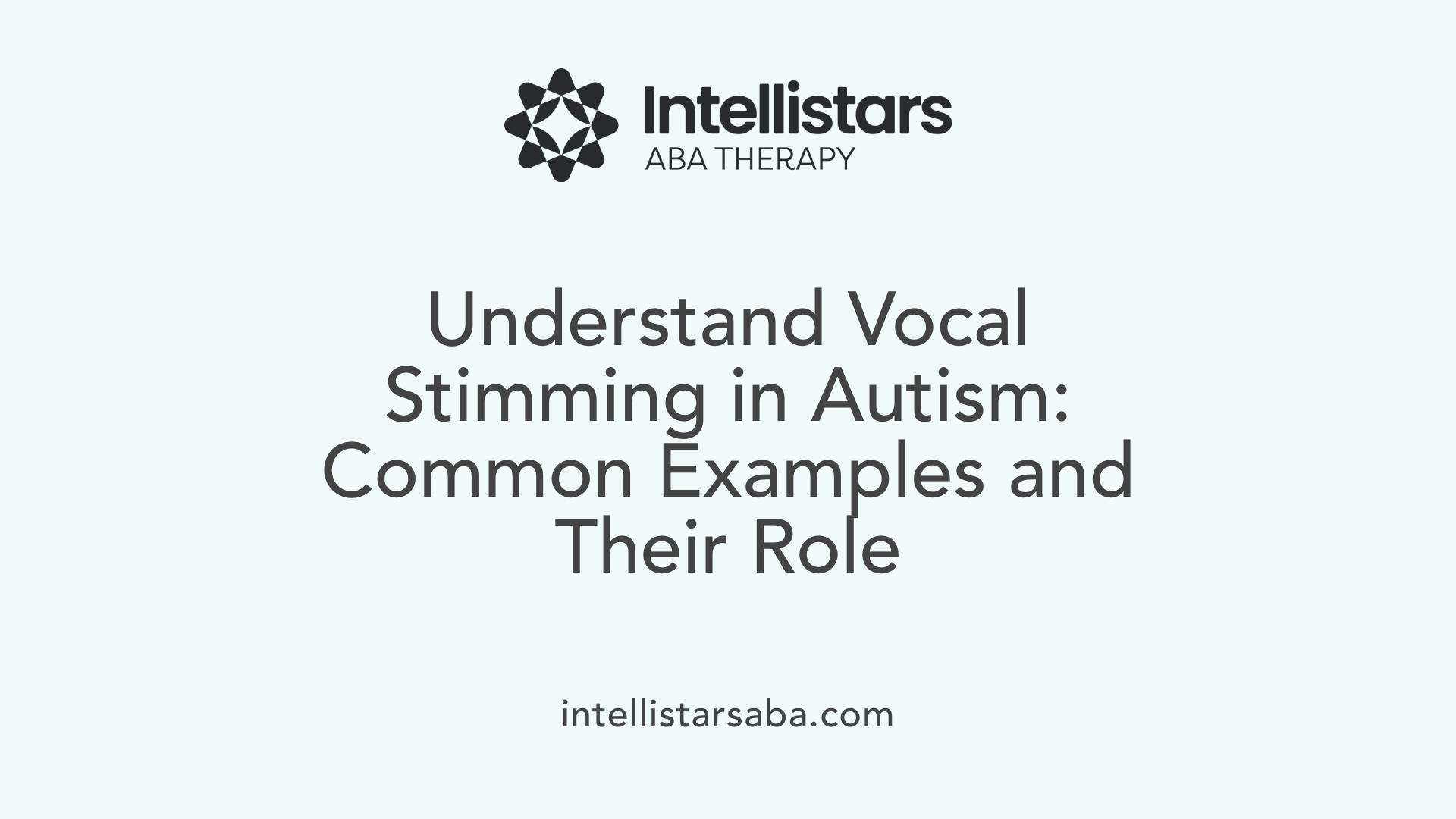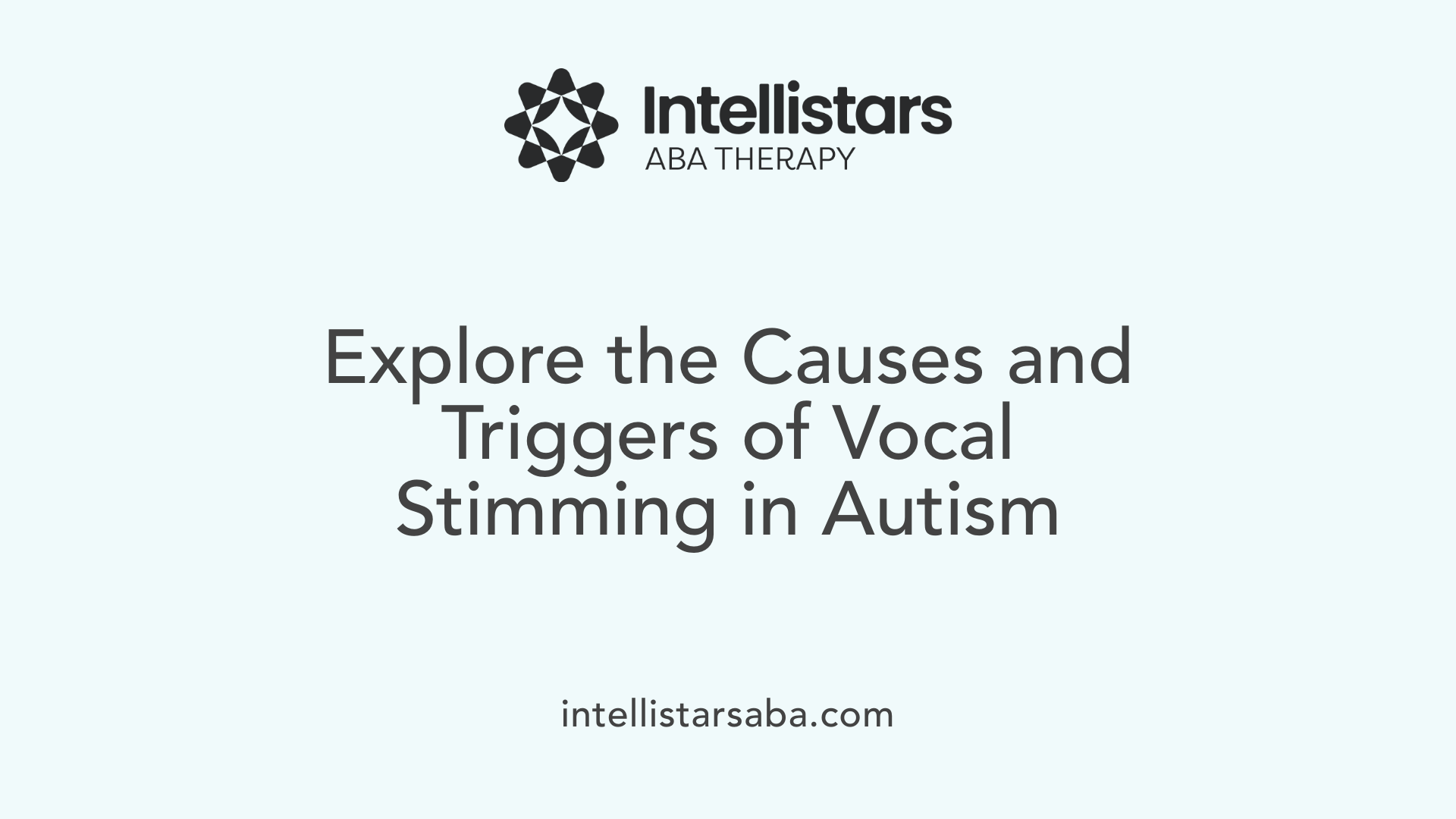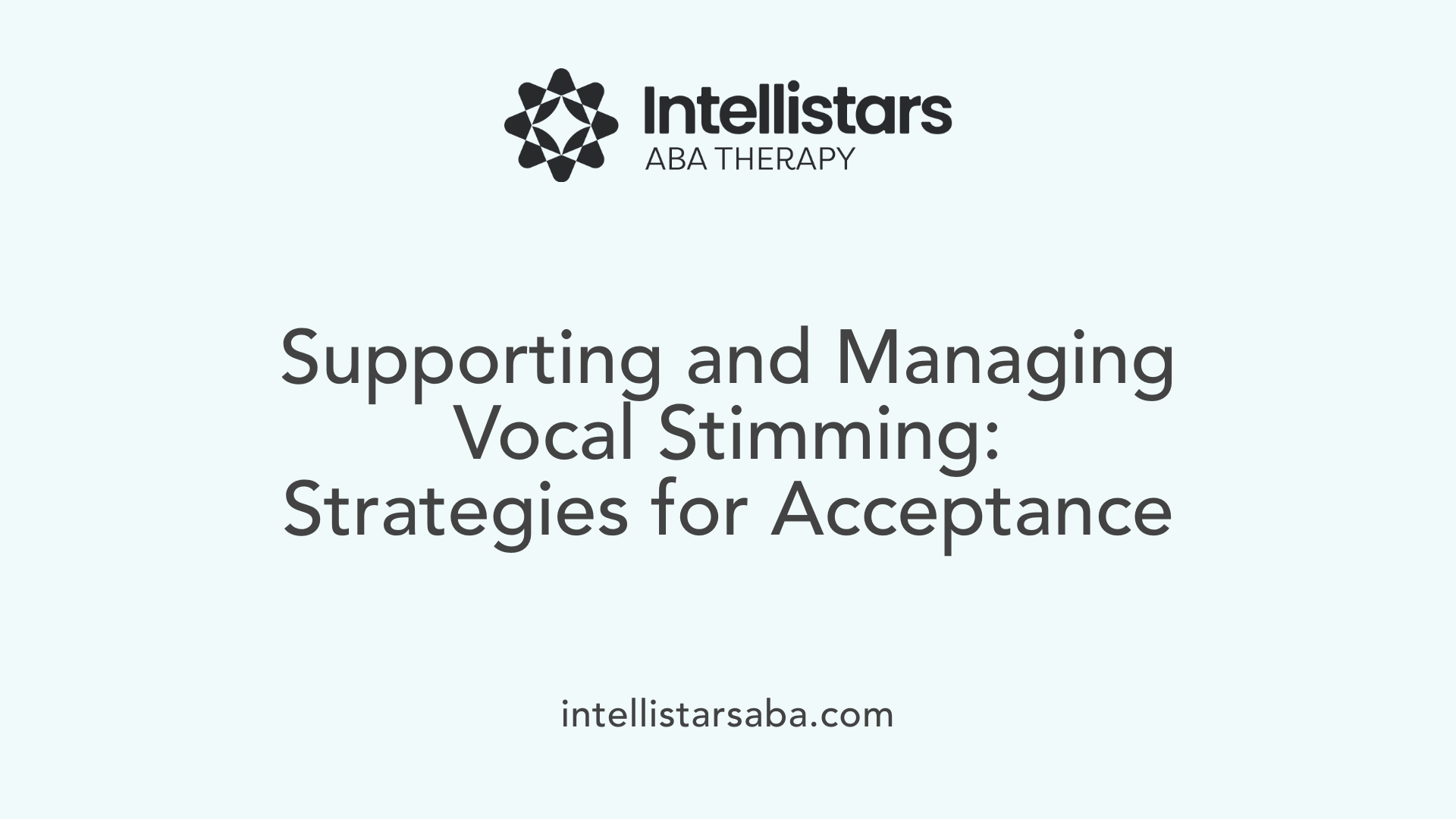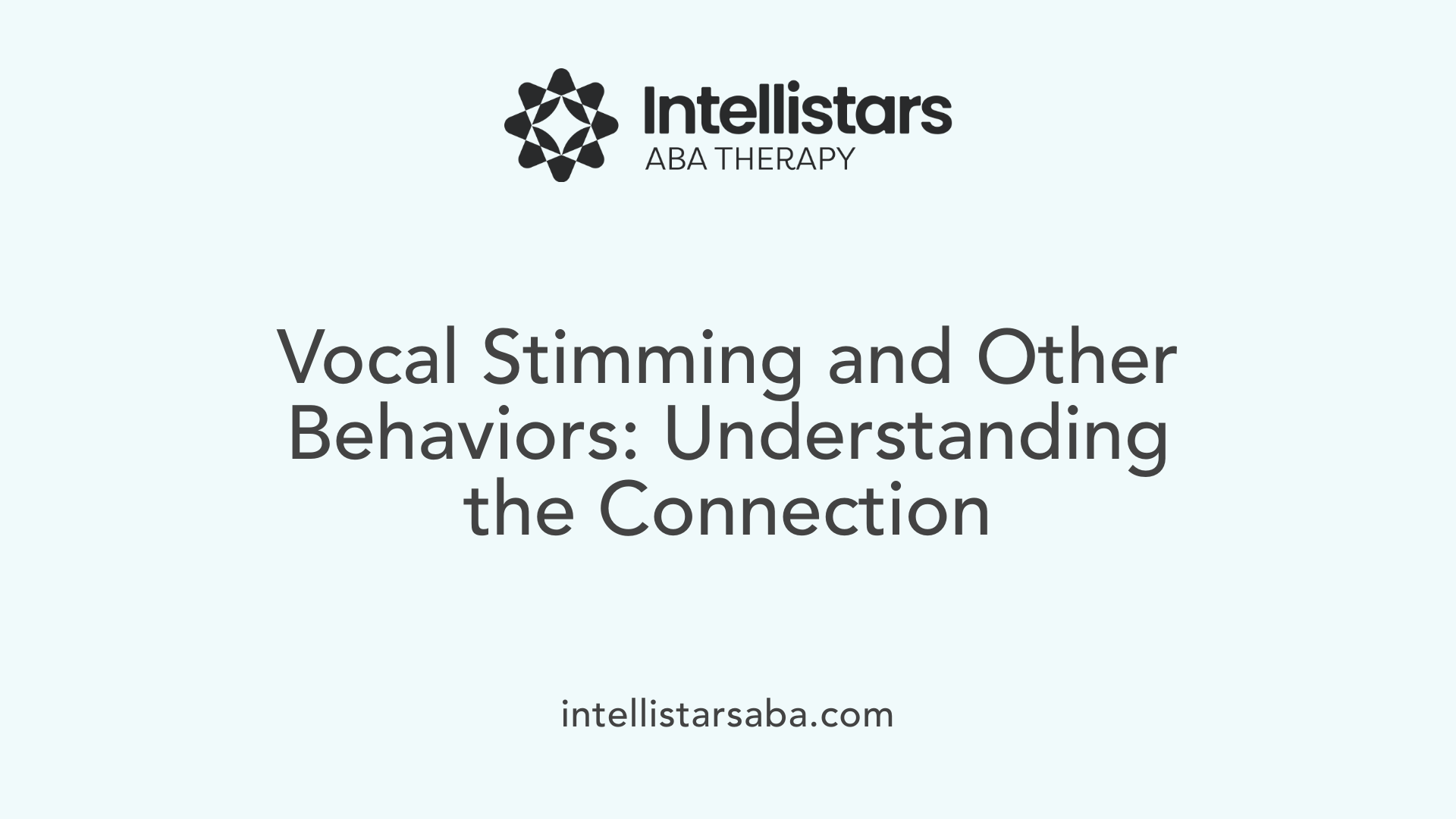An Introduction to Vocal Stimming in Autism
Vocal stimming, a common behavior observed in many individuals on the autism spectrum, involves the repetitive use of sounds, noises, or speech patterns that serve vital functions such as self-regulation and emotional expression. Recognized as a natural part of self-soothing and sensory management, vocal stimming varies widely among individuals and can include a range of behaviors from humming and singing to repeated phrases and environmental sounds. This article explores the types, causes, functions, and management strategies related to vocal stimming in autism, offering insights that support understanding and acceptance.
What Is Vocal Stimming in Autism and Common Examples

What is vocal stimming in autism and what are some common examples?
Vocal stimming, also known as auditory stimming, is a behavior where individuals produce repetitive sounds, noises, or speech patterns as a way to self-regulate and cope with sensory overload, emotions, or excitement. For many people with autism, these behaviors serve important functions, helping them feel calmer, more focused, or more in control during overwhelming situations.
Common vocal stimming actions include humming, singing, shouting, shrieking, making animal sounds, repeating words or phrases—sometimes called echolalia or palilalia—and throat-clearing. Others may mimic environmental sounds, whistle, or engage in murmuring, grunting, or sighing. Sometimes, individuals may repeat lines from TV shows or movies, or imitate noises they hear in their surroundings.
These behaviors are often a natural part of how autistic individuals manage their sensory and emotional worlds. They can act as a soothing balm during stress or anxiety, help with focus, or facilitate emotional expression. For example, humming can block out loud or unpleasant noises, while echolalia might be a method of communication or a way to process language.
While vocal stimming is generally harmless and can be an vital self-regulation tool, it can sometimes lead to social challenges or be disruptive, especially in settings that prioritize quiet or structured speech. Recognizing the importance of vocal stimming means understanding its purpose. Support strategies include offering alternative sensory outlets, setting routines, and working with therapies such as speech or occupational therapy.
In addition, creating safe spaces where individuals feel comfortable expressing their stims, and educating others about their significance, can reduce social stigma and promote acceptance. Managing vocal stimming should focus on supporting and understanding the behavior rather than suppressing it unless it causes harm, ensuring the emotional and sensory needs of autistic individuals are respected.
Causes and Triggers of Vocal Stimming Behaviors

What causes or triggers vocal stimming behaviors in autistic individuals?
Vocal stimming in autistic individuals is often a way to self-regulate sensory input, emotions, and stress. These behaviors include humming, repeating words or phrases, squealing, or mimicking sounds, and serve various functions such as calming, expressing feelings, or managing sensory overload.
Several common triggers can lead to vocal stimming. Sensory overload, where an individual is overwhelmed by loud noises, bright lights, or busy environments, often prompts vocal responses as a coping strategy. Emotional regulation is another key factor; when feeling anxious, frustrated, or excited, vocal stimming helps manage these intense feelings.
Stress and anxiety are powerful triggers that can cause individuals to engage in vocal behaviors to find relief or control. Boredom and excitement also frequently lead to vocal stim, providing sensory stimulation or a way to express heightened emotions.
Understanding these triggers is essential for supporting individuals who stim vocally. Recognizing when and why vocal stimming occurs helps caregivers adopt strategies like environmental modifications, offering alternative sensory outlets, or creating routines to reduce overwhelming stimuli.
Overall, vocal stimming is a natural and functional behavior that supports emotional and sensory regulation. Managing it only when it causes harm or distress ensures respect for personal expression while fostering a supportive environment.
Developmental Aspects and Persistence of Vocal Stimming

How does vocal stimming develop in children?
Vocal stimming behaviors in children, especially those on the autism spectrum, often begin early in childhood. These behaviors include humming, repeating phrases, mimicking sounds, or making noises like squealing or throat clearing. Such actions primarily serve to help children regulate their emotions, process sensory input, or express themselves when verbal communication may still be developing.
As children grow, their communication skills and self-awareness typically improve, which can influence their use of vocal stimming. Many children learn to substitute these behaviors with more functional communication, such as speaking or using alternative communication methods. However, vocal stimming like humming or repeating words often remains a part of their behavioral repertoire.
Do autistic children typically grow out of vocal stimming behaviors?
In general, vocal stimming tends to persist in autistic individuals rather than fully disappear. While some children may reduce the frequency or loudness of these behaviors over time, they usually do not completely eliminate them. These behaviors are often deeply rooted as mechanisms for self-regulation, offering comfort and sensory organization.
Supportive therapies, including speech and occupational therapy, aim to help children develop more adaptive communication strategies. They focus on understanding the purpose of vocal stimming and guiding children towards functional alternatives, rather than trying to suppress these natural behaviors.
How does vocal stimming change over time?
Vocal stimming may adapt and evolve through different life stages. In some cases, children become more aware of social norms and may learn to control or hide certain behaviors in public. However, many individuals continue to use vocal stimming as a coping tool, especially in stressful or overwhelming situations.
The persistence of vocal stimming highlights its role as a vital self-regulation method. Rather than viewing it as problematic, understanding its purpose allows caregivers and educators to support individuals in managing these behaviors appropriately.
Supporting communication skills and behavioral development
Supporting children’s communication development involves creating environments that recognize and validate their behaviors while encouraging more functional communication. Using visual supports, social stories, and alternative calming strategies like deep breathing or sensory toys can help children transition away from excessive vocal stimming.
Education about the purpose and naturalness of stimming behaviors enhances understanding and reduces social stigma. Reinforcing positive communication techniques and offering safe spaces for stimming can foster emotional well-being and social inclusion over time.
Support and Management Strategies for Vocal Stimming

How can vocal stimming be managed or supported in individuals with autism?
Supporting individuals who engage in vocal stimming involves creating an environment that is accepting and understanding of their behaviors. It’s important to recognize that vocal stimming is a natural way for many people, especially those with autism, to self-regulate, express emotions, or manage sensory overload.
A foundational approach is to establish a safe space where vocalizations are not met with judgment or punishment. This encourages comfort and self-acceptance. Observing what triggers vocal stimming helps identify specific causes, such as sensory overload, stress, or boredom. Once triggers are known, caregivers can introduce appropriate replacement behaviors. For example, humming, singing, or using fidget toys can serve as outlets that fulfill similar sensory needs without disrupting daily routines.
Implementing structured routines and offering sensory outlets are also useful strategies. Routine activities help reduce unpredictability, which can decrease anxiety. Sensory tools like stress balls, textured objects, or rhythmic activities like drumming can provide alternative ways to engage the senses.
Designated quiet or stim-friendly spaces can support individuals during overwhelming moments, giving them a safe environment to express themselves without causing distress to others. Moreover, professional therapies such as speech therapy or behavioral interventions like Applied Behavior Analysis (ABA) can tailor strategies specific to the individual’s needs. These therapies can teach new communication skills and help manage behaviors effectively.
Overall, respecting the person’s need to stim and teaching those around them about the purpose of vocal stimming fosters understanding. Encouraging self-awareness and personal boundaries, while offering supportive tools, enhances emotional well-being and helps individuals navigate social environments comfortably.
The Overlap Between Vocal Stimming and Other Behaviors

Is vocal stimming always associated with autism, or can it occur in other contexts?
Vocal stimming is most often linked to autism, as it helps individuals self-regulate emotions, manage sensory overload, or cope with stress. However, it is not exclusive to autistic individuals. People without autism, including children, adults, and those with other conditions like ADHD, can also engage in vocal stimming behaviors.
In non-autistic populations, vocal stimming might look like humming, repeated words or phrases, or making sounds like squealing or throat clearing. These behaviors usually serve as calming mechanisms or ways to focus attention. They are typically harmless and only become concerning when they are excessive, disruptive, or cause social difficulties.
Understanding that vocal stimming can appear in diverse groups helps promote acceptance and appropriate management. Recognizing its function in emotional or sensory regulation emphasizes its natural and adaptive roles across different individuals, not just those with autism.
Recognizing Harmful Vocal Stimming and When To Seek Support
Are there any signs that vocal stimming is harmful or needs intervention?
Most vocal stimming behaviors are natural responses that serve important self-regulatory functions for autistic individuals and others. These behaviors, including humming, repeating phrases, or mimicking sounds, are generally harmless when they do not interfere significantly with daily routines or social interactions.
However, certain signs indicate that vocal stimming might be problematic and could benefit from professional support or management strategies. Signs of concern include behaviors that are excessive or loud, which might cause discomfort or distress to others. Persistent and disruptive sounds may hinder social engagement or learning environments.
Physical health issues can also signal the need for intervention. For example, if vocal stimming results in strain, soreness, hoarseness, or pain in the vocal cords or throat, it’s important to address these medical concerns. Self-injury, such as head banging combined with vocal cues or behaviors that cause physical harm, is a clear indicator that support is needed.
Emotional distress linked to vocal stimming is another indicator. If the behavior causes the individual to become agitated, distressed, or overwhelmed, or if it is driven by stress or anxiety that is not being managed effectively, intervention strategies may be necessary.
In many cases, the goal is to respect vocal stimming as a natural and helpful behavior. But when it leads to negative consequences—such as social exclusion, physical discomfort, or emotional upset—it's important to seek support. Strategies can include creating safe spaces, offering preferred alternative sensory outlets, or teaching appropriate contexts for vocalizations.
Monitoring how vocal stimming impacts a person’s overall well-being and daily functioning is essential in deciding when to seek help. Consulting with professionals, such as speech or occupational therapists, can assist in developing tailored interventions that support the individual's needs without discouraging natural behaviors.
Generally, understanding the purpose behind vocal stimming and recognizing its signs of distress helps caregivers and individuals determine the appropriate time to seek support while fostering acceptance of these natural behaviors.
Vocal Stimming in Adulthood and Its Significance
Can vocal stimming behaviors be observed in adults with autism?
Vocal stimming is not exclusive to children; many adults with autism continue to engage in these behaviors throughout their lives. Vocal stimming in adults often manifests as repeating phrases, humming, singing, or making other sounds repeatedly. These behaviors serve essential functions, such as self-regulation, managing sensory inputs, expressing emotions, or reducing stress.
For many autistic adults, vocal stimming remains a vital part of daily life. It helps them cope with overwhelming environments, calm their nerves, or focus their thoughts. These behaviors can include simple noises like humming or throat clearing, echoing phrases from media, or engaging in rhythmic vocalizations.
The importance of vocal stimming for adults lies in its role as a natural coping mechanism. It provides sensory input or emotional release, easing anxiety or alertness. Recognizing that these behaviors continue into adulthood underscores their function as harmless, self-supporting activities rather than signs of disorder.
Do adults with autism manage vocal stimming approaches?
Management strategies for adult vocal stimming focus on understanding and accommodating these behaviors rather than suppressing them. Professionals may suggest creating supportive environments where vocal stim behaviors are accepted, especially in social or work settings.
The approaches include:
- Environmental adjustments: Reducing overwhelming stimuli by creating calm spaces.
- Alternative outlets: Using stim toys, rhythmic activities, or deep-b breathing techniques as substitutes.
- Communication training: Enhancing social skills can help individuals express themselves in socially acceptable ways without suppressing natural behaviors.
- Therapeutic support: Occupational therapy and behavioral interventions can assist in managing behaviors that become disruptive or distressing.
Is there a continuity of stimming behaviors over time?
Yes, many individuals experience a consistency in their stimming behaviors over their lifetime. While the intensity or specific sounds may change, the core purpose remains the same—self-regulation and emotional management.
Some adults may develop more discreet or socially acceptable forms of vocal stimming, adapting to different social contexts. Others might use technology or alternative behaviors to fulfill similar needs.
Understanding this continuity emphasizes that vocal stimming is part of a broader spectrum of adaptive behaviors. Accepting and supporting these behaviors can lead to better mental well-being and social integration.
| Aspect | Details | Notes |
|---|---|---|
| Presence in adulthood | Common | Continues over lifespan; |
| Management strategies | Environmental, behavioral, therapeutic | Focus on support, not suppression; |
| Behavioral changes | Slight variations, adaptations | Reflects changing social context |
| Functions | Self-regulation, emotional expression, sensory input | Core reason for vocal stimming |
| Benefits | Comfort, focus, stress relief | Important for well-being |
| Risks | Social perception, self-injury | When behaviors are extreme or harmful |
Vocal stimming in adulthood remains a valuable, natural part of many autistic individuals’ lives. Recognizing its purpose and implementing supportive management can help foster acceptance and improve overall quality of life.
Embracing and Supporting Vocal Stimming Behaviors
Understanding vocal stimming as a natural and functional aspect of autism is crucial for fostering acceptance and support. Recognizing its roles in self-regulation, emotional expression, and sensory processing helps reduce misconceptions and promotes strategies that accommodate these behaviors. By creating understanding environments, implementing supportive interventions, and respecting individual differences, caregivers, educators, and peers can contribute to a more inclusive society where autistic individuals feel validated in their behaviors, including vocal stimming.
References
- Vocal Stimming in Autism - Exceptional Individuals
- Understanding Vocal Stimming in ADHD and Autism - Verywell Mind
- Vocal Stimming in Autism: Causes and Management
- What is Vocal Stimming in children with autism, and what causes it?
- Vocal Stimming in Autism: What Parents Need to Know - Blue ABA
- Stimming and autism - Leicestershire Partnership NHS Trust
- Stimming and Autism: Are They Related? - WebMD
- Vocal Stimming in Autism: What Parents Need to Know - Blue ABA
- Vocal Stimming in ADHD: Examples, Causes, and Management






